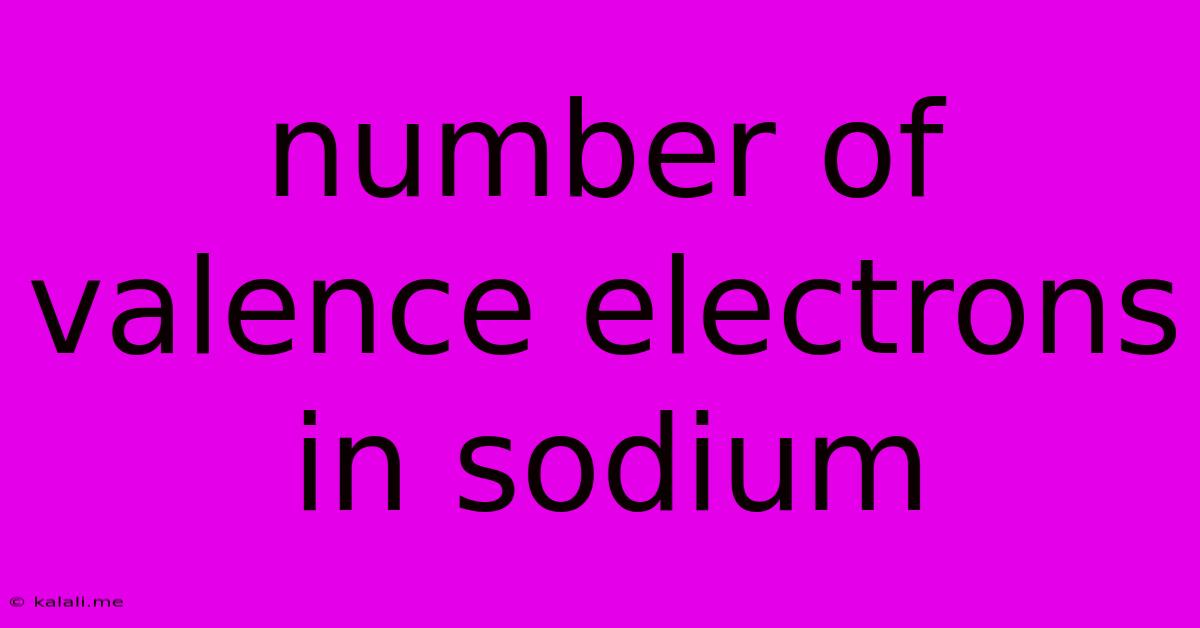Number Of Valence Electrons In Sodium
Kalali
May 10, 2025 · 3 min read

Table of Contents
Understanding the Number of Valence Electrons in Sodium
Sodium, a highly reactive alkali metal, plays a crucial role in various biological and industrial processes. Its chemical behavior is largely dictated by its electronic structure, specifically the number of valence electrons. This article will delve into understanding why sodium possesses only one valence electron, exploring its electronic configuration and implications for its reactivity. Understanding this fundamental property is key to comprehending sodium's role in chemistry and its various applications.
What are Valence Electrons?
Before diving into sodium's valence electrons, let's define the term. Valence electrons are the electrons located in the outermost shell (or energy level) of an atom. These electrons are the most loosely held and therefore participate in chemical bonding. They determine an element's reactivity and how it will interact with other atoms to form molecules and compounds. The number of valence electrons directly impacts an element's chemical properties, influencing its oxidation state and the types of bonds it can form. Elements with similar numbers of valence electrons often share similar chemical behaviors, a principle observed throughout the periodic table.
Sodium's Electronic Configuration
Sodium (Na) has an atomic number of 11, meaning it possesses 11 protons and 11 electrons in a neutral atom. These electrons are distributed across different energy levels according to the Aufbau principle and Hund's rule. The electronic configuration of sodium is 1s²2s²2p⁶3s¹.
This configuration tells us:
- 1s²: Two electrons occupy the first energy level (shell).
- 2s²2p⁶: Eight electrons fill the second energy level. The 2s subshell holds two electrons, and the 2p subshell holds six.
- 3s¹: A single electron occupies the 3s subshell in the third energy level.
Determining Sodium's Valence Electrons
The outermost shell of sodium is the third energy level (n=3), which contains only one electron in the 3s orbital. This solitary electron is sodium's valence electron. Therefore, sodium has one valence electron. This single valence electron is responsible for sodium's high reactivity. It readily loses this electron to achieve a stable octet configuration, resembling the noble gas neon.
Implications of Sodium's Single Valence Electron
The presence of only one valence electron explains sodium's characteristic properties:
- High Reactivity: Sodium readily loses its valence electron to form a +1 ion (Na⁺), achieving a stable electron configuration. This ease of electron loss contributes to its high reactivity, particularly with nonmetals like chlorine and oxygen. Sodium readily reacts with water, producing hydrogen gas and sodium hydroxide.
- Formation of Ionic Compounds: The tendency to lose its valence electron leads to the formation of ionic compounds. In ionic bonding, sodium donates its electron to a more electronegative atom, resulting in electrostatic attraction between the oppositely charged ions. Sodium chloride (NaCl), common table salt, is a prime example of this type of bonding.
- Metallic Bonding: Sodium's single valence electron also contributes to its metallic bonding. In metallic solids, valence electrons are delocalized, forming a "sea" of electrons that holds the positively charged metal ions together. This accounts for sodium's characteristic metallic properties like conductivity and malleability.
In conclusion, sodium's single valence electron is the key to understanding its chemical behavior. This crucial property explains its high reactivity, its tendency to form ionic compounds, and its metallic bonding characteristics. Understanding valence electrons is fundamental to grasping the chemical properties of elements and predicting their reactivity.
Latest Posts
Latest Posts
-
Who Did Alan Jackson Have An Affair With
Jul 04, 2025
-
How Much Is 500 Grams Of Ground Beef
Jul 04, 2025
-
1 Pound Pasta Is How Many Cups
Jul 04, 2025
-
How Many Cans Of Soda Are In A 2 Liter
Jul 04, 2025
-
How Do U Say Of In Spanish
Jul 04, 2025
Related Post
Thank you for visiting our website which covers about Number Of Valence Electrons In Sodium . We hope the information provided has been useful to you. Feel free to contact us if you have any questions or need further assistance. See you next time and don't miss to bookmark.